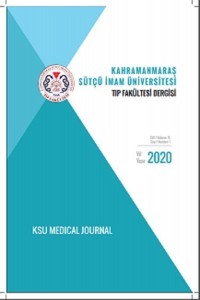Tarçının (Cinnamon) Yüksek Glukoz Konsantrasyonlarına Maruz Bırakılan İnsan Eritrositlerinde (in vitro) Protein Glikozilasyonu, Na+-K+ ATPaz, Ca++ ATPaz ve Lipid Peroksidasyonu Düzeylerine Etkisinin Araştırılması
Tarçın(cinnamon), Na+-K+ ATPaz, Ca++ ATPaz, Lipid Peroksidasyonu, Eritrosit Membranı
In vitro Investigation of the Effect of Cinnamon on Protein Glycosylation, Na+-K+ ATPase, Ca++ ATPase and Lipid Peroxidation in Human Erythrocytes Exposed to High Glucose Concentration
Cinnamon, Na+-K+ ATPase, Ca++ ATPase, Lipid Peroxidation,
___
- King GL, Banskota NK. Mechanisms of diabetic microvascular complications. In: Kahn, C.R, Weir GC. eds, Joslin's Diabetes Mellitus. (International Ed. Thirteenth Ed. Companv). 1994; 634-648.
- Maxwell SRJ, Thomason H, Sandler D, Leguen C, Baxter MA, Thorpe GHG, Jones AF, Barnett AH. Poor glycaemic control is associated with reduced serum free radical scavenging (antioxidant) activity in non-insulin-dependent diabetes mellitus. Ann Clin Biochem. 1997; 34:638-644.
- Orei NN, Zidek W, Tepel M. Increased intracellular generation of reactive oxygen species in mononuclear leukocytes from patients with diabetes mellitus type 2. Exp Clin Endocrinol Diabetes. 2000; 108(3):175-80.
- Jain SK, Lim G. Lipoicacid decreases lipid peroxidation and protein glycosylation and increases (Na+, K+ ) and Ca+2 ATPase activities in high glucose-treated human erythrocytes. Free Radical Biology & Medicine. 2000; 11:1122-1128.
- Jain SK, Lim G. Pyridoxine and pyridoxamine inhibits superoxide radicals and prevents lipid peroxidation, protein glycosylation, and Na+, K+ -ATPase activity reduction in high glucose-treated human erythrocytes. Free Radical Biology & Medicine. 2001; 12:595-604.
- Davis FB, Davis PJ, Nat G, Blas SD, Macgillivra M, Gutman S, Feldman MJ. The effect of in vivo glucose administration on human erythrocyte Ca++-ATPase activity and on enzyme responsiveness in vitro to thyroid hormone and calmodulin. Diabetes. 1985; 34(7):639-646.
- Bilgin R. Glukozun Eritrosit Zarlarında Bulunan Na+- K+ ATPaz ve Ca+2 ATPaz Enzim Aktivitelerine Etkisinin İn Vitro ve İn Vivo Koşullarda Araştırılması. Çukurova Üniversitesi Doktora Tezi, Adana. 1995; 100p.
- Kızıltunç A, Akçay F, Polat F, Kuşkay S, Şahin YN. Reduced lecithin: Cholesterol acyltransferase (LCAT) and Na+, K+ -ATPase activity in diabetic patients. Clinical Biochemistry. 1997; 2:177-182.
- Gürbilek M, Dağlar C, Aköz C. The effect of disease duration on of erythrocyte membrane Na+, K+ -ATPase enzyme activity, lipid peroxidation, and DHEA(S), glucose and lipid levels in the diabets mellitus patients. Turk J. of Biochem. 2004; 29(39); 237-242. Khan A, Safdar M, Khan MMA, Khattak KN, Anderson RA. Cinnamon Improves Glucose and Lipids of People With Type 2 Diabetes. Diabetes Care. 2003; 26:3215–3218.
- Bruneton J. Pharmacognosy, Phytochemistry, Medicinal Plants. Lavoisier printing press, Paris. 1995; 509.
- Karnick CR. Pharmacopoeial Standards of Herbal Plants. Sri Satguru printing press, Delhi. 1994; 1138p.
- Kim SH, Hyun SH, Choung SY. Anti-diabetic effect of cinnamon extract on blood glucose in db/db mice. Journal of Ethnopharmacology. 2005; 18:3953-3958
- Kitazuru ER, Moreira AVB, Mancini-Filho J, Delince´e H, Villavicencio ALCH. Effects of irradiation on natural antioxidants of cinnamon (Cinnamomum zeylanicum N.). Radiation Physics and Chemistry. 2004; 71; 37–39.
- Shan B, Cai YZ, Sun M, Corke H. Antioxidant capacity of 26 spices extracts and characterization of their phenolic constituents. J. Agric Food Chem. 2005; 53(20):7749-59.
- Blomhoff R. Antioxidants and oxidative stres. Tidsskr Nor Laegeforen. 2004; 124(12): 1643-5.
- Lopez P, Sanchez C, Batlle R, Nerin C. Solid- and vapour-phase antimicrobial activities of six essential oils: Susceptibility of selected food bourne bacterial and fungal strains. J. Agri Food Chem. 2005; 53(17):6939-46.
- Wichtl M, Bisset, NG. Herbal Drugs and Phytopharmaceuticals. Medpharm Scientific printing press. Stuttgart. 1994; 386p.
- Moretti N, Rabini RA, Nanetti L, Grechi G, Curzi MC, Cester N, Tranquilli LA, Mazzanti L. Sialic acid content in erythrocyte membranes from pregnant women affected by gestational diabetes. Metabolism. 2002; 51(5):605-608.
- Mazzanti L, Rabini RA, Testa I, Bertoli E. Modifications induceed by diabetes on the physicochemical and functional properties of erythrocyte plasma membrane. European J. Clin. Invest. 1989; 19:84-89.
- Flecha FG, Bermudez MC, Cedola NN, Gagliardino JJ, Rossi JP. Febs. Lett. 1990; 244(2):484-486.
- Ames BN. Asay of inorganic phosphate. Methods in Enzymology. Academic Press. 1966; 8:115. Yagi K. Assay for blood plasma or serum. Methods in Enzymolgy. 1984; 105:328-337.
- Jain SK. Hyperglycemia Can Cause Membrane Lipid Peroxidation and Osmatic Fragility in Human Red Blood Cells. Journal of Biological Chemistry. 1989; 264(35):21340-21345.
- Lowry O, Rosenbraugh N, Farr L, Randall R. Protein measurement with theophilin-phenol reagent. J. Biol. Chem. 1951; 183:265–275.
- ISSN: 1303-6610
- Yayın Aralığı: Yılda 3 Sayı
- Başlangıç: 2004
- Yayıncı: Kahramanmaraş Sütçü İmam Üniversitesi
İNFLAMATUAR AĞRI MODELİNDE PLATİN-MELOKSİKAM METAL KOMPLEKSİNİN ANTİ-HİPERNOSİSEPTİF ETKİLERİ
Selma YAMAN, Seda AVNİOĞLU, Kübra KÜÇÜK, Derya ALAKUŞ, Büşra Nur DEMİRCİ, Harun MUSLU, Ayşegül GÖLCÜ, Tufan MERT
İmmün Trombositopenik Purpura Etyolojisinde Brusella
Tuğba Kandemir GÜLMEZ, Hüsnü Maraşli MARAŞLI, Büşra SEĞMEN, Zübeyde DİNÇER, Can ACIPAYAM, Mehmet DAVUTOĞLU, Esra KAYA
Venöz Ülser Tedavisinde Venoaktif İlaçlar
Muhammet Mesut Nezir ENGİN, Nefise ARIBAŞ ÖZ, Yunus ŞENGÜN, Furkan TİMUR, Kenan KOCABAY
GERİATRİK HASTALARDA FARKLI ÖLÇEKLER KULLANILARAK KIRILGANLIK PREVALANSININ BELİRLENMESİ
Sedat ÖZDEMİR, Zeynel Abidin ÖZTÜRK, İbrahim Halil TÜRKBEYLER, Fikri ŞİRİN, Mehmet GÖL
KONVERSİYON BOZUKLUĞU OLAN HASTALARDA SEREBELLAR HACMİN SAĞLIKLI KONTROLLERLE KARŞILAŞTIRILMASI
